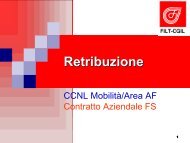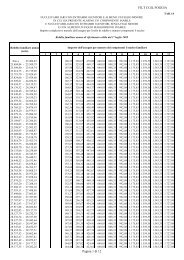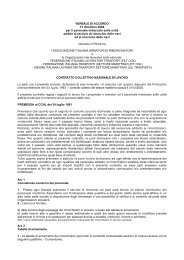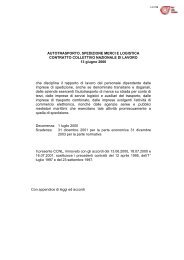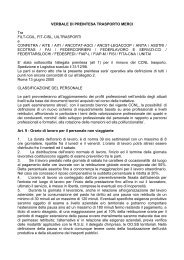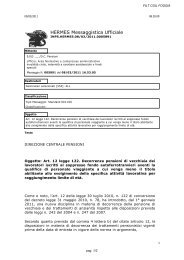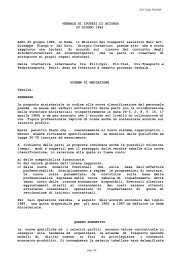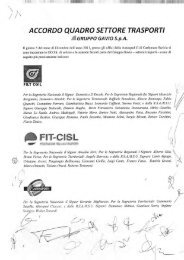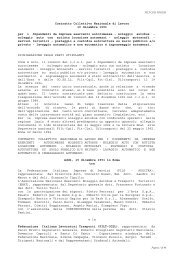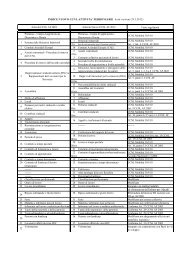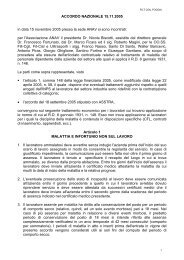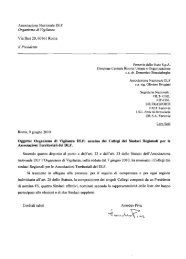Outlook for Air Transport to the Year 2025 - FILT CGIL Foggia
Outlook for Air Transport to the Year 2025 - FILT CGIL Foggia
Outlook for Air Transport to the Year 2025 - FILT CGIL Foggia
- No tags were found...
Create successful ePaper yourself
Turn your PDF publications into a flip-book with our unique Google optimized e-Paper software.
Chapter 2. <strong>Air</strong> <strong>Transport</strong> Trends and Challenges 17ENVIRONMENTAL PROTECTION35. Future growth in civil aviation will take place against a background of increasing public concernregarding <strong>the</strong> environment, particularly with regard <strong>to</strong> aircraft noise and <strong>the</strong> impact of aircraft engine emissions.36. Noise levels near airports are subject <strong>to</strong> two opposing trends: <strong>the</strong> replacement of noisy aircraft by quieterones and <strong>the</strong> increasing number of aircraft movements. ICAO has developed noise certification Standards(Annex 16, Volume I) and in 1990 adopted a worldwide policy enabling States <strong>to</strong> introduce operating restrictionson <strong>the</strong> older, noisier (“Chapter 2”) aircraft covered by <strong>the</strong>se Standards. The phase-out of Chapter 2 aircraft hasnow been completed at most airports where aircraft noise is a problem and governments have been turning <strong>the</strong>irattention <strong>to</strong> concerns that <strong>the</strong> rapid growth of air transport could increase noise levels once again. With a view <strong>to</strong>addressing <strong>the</strong>se concerns, ICAO endorsed <strong>the</strong> concept of a “balanced approach” <strong>to</strong> aircraft noise management.This consists of identifying <strong>the</strong> noise problem at an airport and <strong>the</strong>n analysing <strong>the</strong> various measures available <strong>to</strong>reduce noise through <strong>the</strong> exploration of four principal elements, namely reduction at source (quieter aircraft),land-use planning and management, noise abatement operational procedures, and operating restrictions, with <strong>the</strong>goal of addressing <strong>the</strong> noise problem in <strong>the</strong> most cost-effective manner. In 2006, a new, more stringent ICAOStandard (“Chapter 4”) became applicable.37. As regards aircraft engine emissions, initially <strong>the</strong> main concern was <strong>the</strong> impact on air quality in <strong>the</strong>vicinity of airports, as a result of which ICAO developed Standards <strong>for</strong> <strong>the</strong> control of gaseous emissions throughan engine certification scheme (Annex 16, Volume II). More recently, <strong>the</strong>re have been increasing concerns that<strong>the</strong>se emissions may be contributing <strong>to</strong> global atmospheric problems. The principal issue is aviation’scontribution <strong>to</strong> climate change. In 1999, <strong>the</strong> Intergovernmental Panel on Climate Change (IPCC) prepared aSpecial Report on Aviation and <strong>the</strong> Global Atmosphere 1 which estimated that aircraft contribute about 3.5 percent of <strong>the</strong> <strong>to</strong>tal radiative <strong>for</strong>cing 2 by all human activities. The emissions from aircraft of relevance <strong>for</strong> climatechange include carbon dioxide (CO 2 ), water vapour, nitrogen oxides (NO x ), sulphur oxides and soot.38. The Kyo<strong>to</strong> Pro<strong>to</strong>col <strong>to</strong> <strong>the</strong> UN Framework Convention on Climate Change (UNFCCC), which was adoptedin 1997 and entered in<strong>to</strong> <strong>for</strong>ce on 16 February 2005, requires industrialized countries <strong>to</strong> reduce <strong>the</strong>ir collectiveemissions of certain greenhouse gases, <strong>the</strong> one most relevant <strong>to</strong> aviation being CO 2 . The Kyo<strong>to</strong> Pro<strong>to</strong>col also calls<strong>for</strong> industrialized countries, working through ICAO, <strong>to</strong> limit or reduce emissions from international aviation.39. Future concerns about aviation’s role in both climate change and local air quality are largely due <strong>to</strong> <strong>the</strong>projected continued growth. Because of improvements in fuel productivity, growth rates <strong>for</strong> emissions are lessthan those <strong>for</strong> traffic growth. While fuel productivity improvement is expected <strong>to</strong> continue, <strong>the</strong>re are no easytechnical “fixes” <strong>for</strong> aviation and <strong>to</strong>tal emissions will continue <strong>to</strong> increase.FINANCIAL RESOURCES40. Investment in new aircraft generally follows a cyclical pattern. The latter part of <strong>the</strong> 1980s was a periodof high investment. Investment levels fell away during <strong>the</strong> recession of <strong>the</strong> early 1990s but began <strong>to</strong> build upagain in <strong>the</strong> latter part of <strong>the</strong> 1990s. As illustrated in Figure 2-10, aircraft orders tended <strong>to</strong> peak when <strong>the</strong> airtransport industry was profitable while peak deliveries coincided with financial deficits and low traffic growthleading <strong>to</strong> over-capacity and fur<strong>the</strong>r losses. There are signs however of a change in behavior and airlines maderecord aircraft orders in 2005 despite <strong>the</strong>ir net financial losses. The expected future funding requirement over <strong>the</strong>1. This Report has a Summary <strong>for</strong> Policymakers which is available in six UN languages (Arabic, Chinese, English, French, Russian andSpanish) and is accessible at IPCC’s Web site (www.ipcc.ch). The report itself (over 300 pages) is published in English only and can bepurchased from Cambridge University Press (www.cup.cam.ac.UK).2. Radiative <strong>for</strong>cing is a measure of <strong>the</strong> importance of a potential climate change mechanism.




